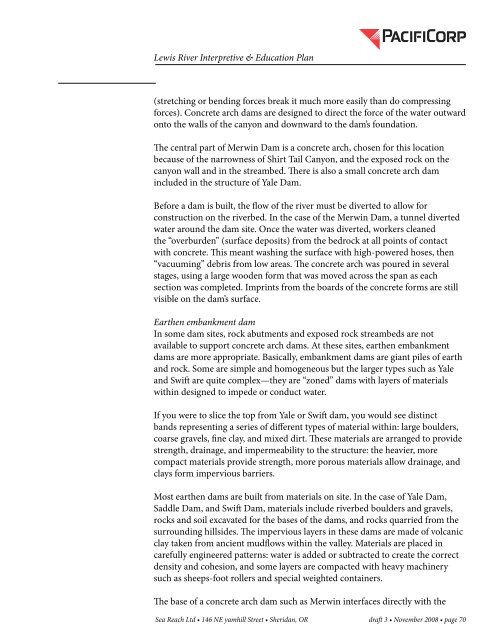The Lewis River Hydroelectric Projects - PacifiCorp
The Lewis River Hydroelectric Projects - PacifiCorp
The Lewis River Hydroelectric Projects - PacifiCorp
You also want an ePaper? Increase the reach of your titles
YUMPU automatically turns print PDFs into web optimized ePapers that Google loves.
<strong>Lewis</strong> <strong>River</strong> Interpretive & Education Plan<br />
(stretching or bending forces break it much more easily than do compressing<br />
forces). Concrete arch dams are designed to direct the force of the water outward<br />
onto the walls of the canyon and downward to the dam’s foundation.<br />
<strong>The</strong> central part of Merwin Dam is a concrete arch, chosen for this location<br />
because of the narrowness of Shirt Tail Canyon, and the exposed rock on the<br />
canyon wall and in the streambed. <strong>The</strong>re is also a small concrete arch dam<br />
included in the structure of Yale Dam.<br />
Before a dam is built, the flow of the river must be diverted to allow for<br />
construction on the riverbed. In the case of the Merwin Dam, a tunnel diverted<br />
water around the dam site. Once the water was diverted, workers cleaned<br />
the “overburden” (surface deposits) from the bedrock at all points of contact<br />
with concrete. This meant washing the surface with high-powered hoses, then<br />
“vacuuming” debris from low areas. <strong>The</strong> concrete arch was poured in several<br />
stages, using a large wooden form that was moved across the span as each<br />
section was completed. Imprints from the boards of the concrete forms are still<br />
visible on the dam’s surface.<br />
Earthen embankment dam<br />
In some dam sites, rock abutments and exposed rock streambeds are not<br />
available to support concrete arch dams. At these sites, earthen embankment<br />
dams are more appropriate. Basically, embankment dams are giant piles of earth<br />
and rock. Some are simple and homogeneous but the larger types such as Yale<br />
and Swift are quite complex—they are “zoned” dams with layers of materials<br />
within designed to impede or conduct water.<br />
If you were to slice the top from Yale or Swift dam, you would see distinct<br />
bands representing a series of different types of material within: large boulders,<br />
coarse gravels, fine clay, and mixed dirt. <strong>The</strong>se materials are arranged to provide<br />
strength, drainage, and impermeability to the structure: the heavier, more<br />
compact materials provide strength, more porous materials allow drainage, and<br />
clays form impervious barriers.<br />
Most earthen dams are built from materials on site. In the case of Yale Dam,<br />
Saddle Dam, and Swift Dam, materials include riverbed boulders and gravels,<br />
rocks and soil excavated for the bases of the dams, and rocks quarried from the<br />
surrounding hillsides. <strong>The</strong> impervious layers in these dams are made of volcanic<br />
clay taken from ancient mudflows within the valley. Materials are placed in<br />
carefully engineered patterns: water is added or subtracted to create the correct<br />
density and cohesion, and some layers are compacted with heavy machinery<br />
such as sheeps-foot rollers and special weighted containers.<br />
<strong>The</strong> base of a concrete arch dam such as Merwin interfaces directly with the<br />
Sea Reach Ltd • 146 NE yamhill Street • Sheridan, OR draft 3 • November 2008 • page 70
















